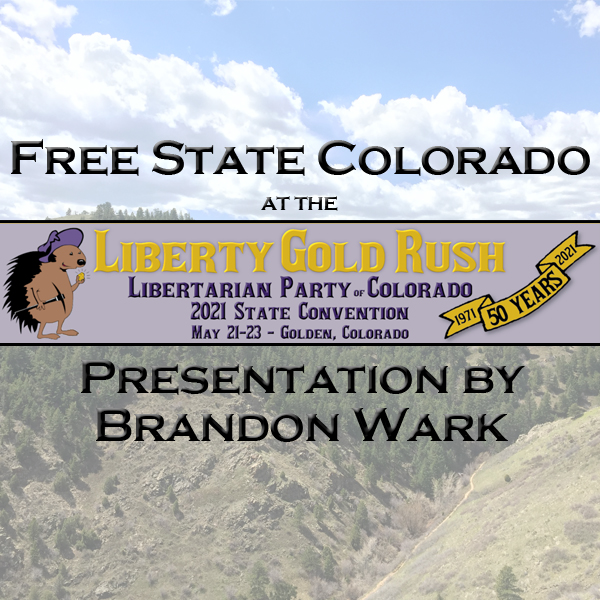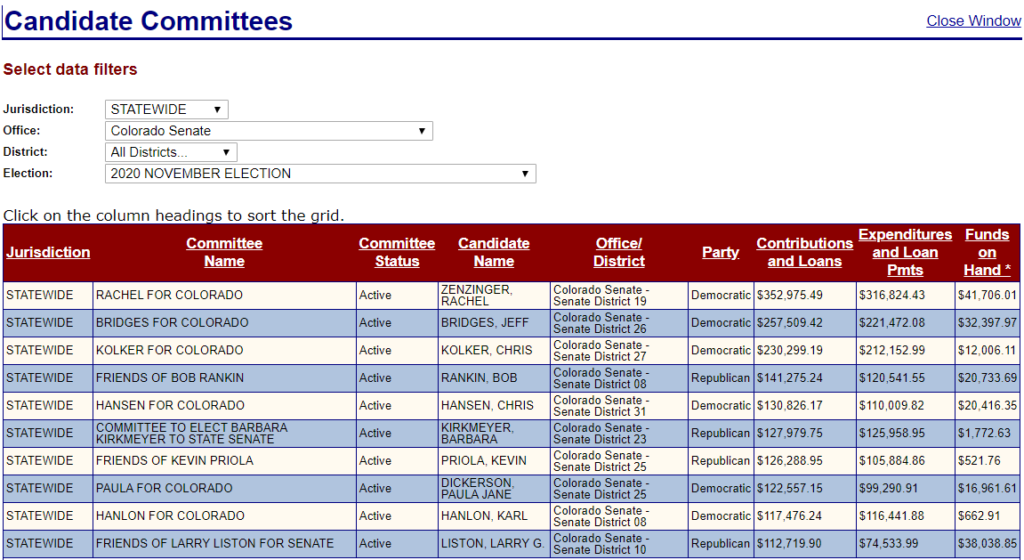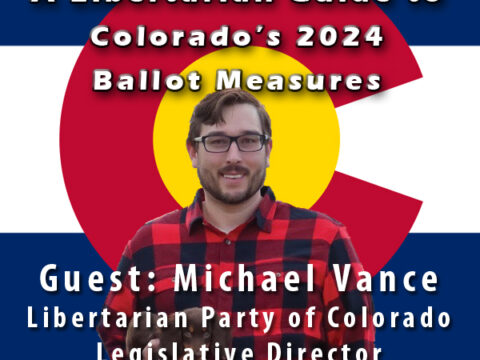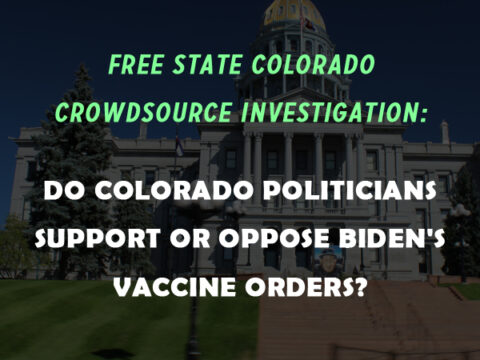Notes for the Free State Colorado Seminar from Brandon Wark at the 2021 Libertarian Party (LP) Convention:
Introduction – Who am I? And Why Should You Care What I Say?
Good day my Fellow Libertarians!
I hope you are having a great convention, making new friends, and plotting new conspiracies to disempower the State.
My name is Brandon Wark, and I have some experience working in Colorado’s Political Scene.
For three years I made my living working in politics.
I’ve worked for the National Association for Gun Rights, a gun rights lobbying group. Rocky Mountain Gun Owners is their Colorado affiliate.
Aside from working at the State Capitol, I’ve worked on Tim Neville’s US Senate Campaign, Tom Tancredo’s brief 2018 campaign for Governor, and a variety of local State House, Senate, and County races.
My goal is to share what I’ve learned to help get Libertarians elected in Colorado.
It is possible, but it is going to take money, volunteers, and most importantly organization.
First, I’ll speak about Colorado’s Political Landscape, what it looks like, who are some key players, and what issues Libertarians might want to focus on.
Then I’ll talk about how to elect candidates to office, based on what I’ve learned.
Thank you very much for being here today, let’s get started
Colorado’s Libertarian Political History:
The political boundary known as the State of Colorado was initiated in September, 1876.
Colorado was the first state to give women the right to vote by referendum (1893 Election)
Since 1912, Colorado has been a Home Rule State: Colorado is one of 30 recognized as a Home Rule State, having amended its constitution to grant municipalities the ability to exercise local control of their individual governments.(source)
Galt’s Gulch, the Capitalist Paradise in Ayn Rand’s seminal Atlas Shrugged, was located somewhere in Colorado (Published in 1957)
Of course, the Libertarian Party formed in Colorado in 1971.
Colorado was the first state where the voters rejected an Olympic Games (1972 Ballot Initiative)
And who could forget when Coloradans fought off the Soviet/Cuban invasion in 1984‘s Red Dawn?
Passed in 1992, with just over 111,000 votes, Colorado’s Taxpayer Bill of Rights, or TABOR, restricted the ability of the Colorado Government to raise taxes without approval from Colorado voters.
Amendment 64 made the ballot with less than 4,400 signatures, and passed in 2012 with a margin of just over 266,000 votes, and Colorado became the first state to legalize cannabis.
In 2013, after the Democratic majority in the State Legislature passed tyrannical restrictions on our Right to Keep and Bear Arms, Pro-Gun activists recalled two Colorado Legislators, forced the resignation of a third, and broke the Democrat’s majority in the Legislature. (source)
Gun Ownership is protected right in Colorado, with the State Constitution stating the following: Article II, § 13 “[t]he right of no person to keep and bear arms in defense of his home, person and property, or in aid of the civil power when thereto legally summoned, shall be called in question; but nothing herein contained shall be construed to justify the practice of carrying concealed weapons.” (source)
Current Political Landscape:
The biggest political offices in Colorado are in the Executive Branch,: Governor (Jared Polis), Secretary of State (Jena Griswold), Attorney General (Phil Weiser), and State Treasurer (Dave Young).
The Legislative Branch, also known as the General Assembly has 100 elected members, 35 in Senate, and 65 in the House.
Colorado’s seven Congressional Districts and two Senators, translates to nine votes in the electoral college.
As you may know, Democrats control all Executive Level Offices, all Federal Seats, and command a majority in the State Legislature.
Let’s talk about how Democrats have taken control, and how Libertarians can use these techniques to our advantage.
Colorado has been controlled by the Democrats in both legislative chambers, and the Governor’s office since 2004, except in the Legislature for three election cycles, 2010, 2014, and 2016.
2020 Campaign Spending
As you may expect, Democrats have in many ways bought their Political Power.
In the State House, the biggest spenders of 2020 were:
David Ortiz, District 38 (Arapahoe County) with $221,000.
Brianna Buentello, District 47 (Fremont, Otero. & Pueblo Counties) with $211,000 spent (Buentello, the incumbent) lost in November 2020 to Republican Stephanie Luck.
Brianna Titone, District 27 (Jefferson County), with $194,000 spent. Notice that Libertarian Candidate Cory Schaeffer won more votes than the difference between the two other candidates:
The fifteen highest spending candidates were all Democrats, twelve of them spent over $100,000. (Source)
The Colorado Senate saw big spending, with the largest amount spent by a candidate of $316,000 from Rachel Zenzinger (Source).
In 2020, Democratic candidates spend nearly $6.4 million on their campaigns, whereas Republicans spent less than $2.8 million.
Looking at the past few election cycles, the trend remains the same, but I was surprised to see how much was spent in 2018, a so-called “off-year” election.
Democrats spent over $36 million compared to Republicans $7 million.
Of course, 2018 was a very important year for Colorado, with the usual State Legislative and Congressional races, but also the Governor’s race and other state-wide offices up for grabs.
The Biggest Spenders in all Statewide Races for the current election cycle were mostly for Executive Branch Positions:
- Jared Polis for Governor with $377,000 spent
- Phil Weiser for Attorney General with $137,000 spent
- Jena Griswold for Secretary of State with $101,000 spent
- Beth McCann for Denver DA with $88,000 spent.
- Leroy Garcia for State Senate with $58,000 spent.
Looking at some of the campaign finance reports for these candidates, it seems like they are building their databases, advertising, and using ActBlue, NGPVAN, and other Democratic favorite consulting and marketing companies.
Money is important, if Libertarians want to win elections, we need money.
Looking at the 2020 Election, who were the Big Donors?
Major Donors:
North Fund is a 501(c)(4) based in Washington DC which is a front group for Sixteen Thirty Fund, one of the biggest Democratic Dark Money groups in the country.
Kent Thiry, and Pat Stryker are two of Colorado’s wealthiest political donors.
In 2018, donations flowed from oil and gas companies into Protect Colorado, a pro-energy committee.
If Libertarians want to win, we need BIG DONORS, either individuals or organizations.
Issue Committees:
Aside from candidate committees, issue committees are an extremely powerful force in Colorado elections.
Issue Committees exist to promote a specific ballot initiative or at least a specific subject they can focus on each year.
If you look at Committee information on the Secretary of State’s website, you will see many of the same Registered Agents, mostly consultants associated with Democrats or Republicans.
I recommend you check out my Review of the 2020 Ballot Initiatives.
Some of the key issues that Libertarians can focus on are Gambling, Tax Cuts, and limiting politicians by requiring Voter Approval are all initiatives that passed in 2020 that Libertarians can be happy with.
If Libertarians want to win, we need ISSUES to run on.
Activist Groups
We have seen how Candidates, Big Donors, and Issue Committees wield tremendous political power during the election season, but non-profit “social welfare” groups have become another powerful political tool.
The Supreme Court Ruling on Citizens United changed the Political Spending Dynamic, removing power from political parties, and allowing other organizations like PACs, and Non-Profits to have influence in elections.
Non-profits have been an effective tool for both election work, and legislative activism.
Activist Groups provide an organizational structure that can be used to develop candidates, organize volunteers, build voter databases, and lobby legislators during the Legislative Session.
Democrats took Colorado because they built a structure to last beyond an election cycle.
They fostered community.
And they did this by focusing on issues, and on giving underrepresented groups opportunity to exercise political power.
The Blueprint. This book explains how this new political model started.
Colorado Democracy Alliance, CODA, was the roundtable group that featured the infamous “Gang of Four:” Jared Polis, Pat Strker, Tim Gill, and Rutt Bridges.
These were Tech billionaires and millionaires motivated to support Gay Rights and a board Progessive Agenda.
CODA directed money to over 30 nonprofit organizations and 527 groups in support of Democratic candidates. (source)
Political Activist Groups are nothing new, some of the most well-known include:
OGs – Original Groups:
- AFL-CIO
- CEA – Teacher’s Union
- Planned Parenthood of the Rocky Mountains
- ACLU Colorado
- Colorado Trial Lawyers Association
- Sierra Club
These organizations, through the efforts of the Gang of Four and their allies, built coordination around the groups by putting differences aside, and focusing on getting Democrats elected.
ProgressNow Colorado as the Umbrella Group for Organizing various single-issue groups. Some of those associated:
- One Colorado: LGBTQ – Issue that got Tim Gill, Jared Polis, Pat Stryker motivated
- Conservation Colorado, Colorado Rising: Environmental Groups
- CIRC – Colorado Immigrant Rights Coalition
- Cobalt, Colorado Organization for Latina Opportunity and Reproductive Rights (COLOR), NARAL, Beyond the Bans,
- Interfaith Alliance of Colorado, New Era Colorado, Together Colorado – General Progressive Activist Groups
- America Votes – DC coordination group
- Showing up for Racial Justice
- 9 to 5 Colorado – Working Class Issues
- Centennial State Prosperity – Healthcare Issues
Development Groups:
Emerge Colorado – Train & Support Women Candidates
Media Organizations:
Coloradopols.com – Hardcore Colorado Democrat Blog
Colorado Times Recorder – Partisan “News” Outlet – Sole Purpose is to SMEAR political opponents.
Assocations with Mainstream Outlets: Westword, Denver Post (Ian Silverii), 9News (Kyle Clark)
How To Win
“To have a community, you have to build a community.”
Ted Trimpa (Democratic Strategist, one of the architects behind the Blueprint)
Candidates, Donors, Committees (PACS), Activist Organizations.
Organization can get you volunteers, donors, activism, candidates.
MONEY: State House Races: Spending $25,000 to $200,000 in 2020
- Blueprint Book – Democrats focused less on issues and more on candidates
- Learn from the winners – Collect Campaign Material – Pay attention
- Build Infrastructure – Communications capacity, meetups, campaign trainings,
- Pair Donors with Issues
- Pair Volunteers with Issues
- Single issue groups – “Organizations around issues people care about”
- Social Power precedes Political Power, Develop Social Groups
- Capitalize on Moments or Crisis
- Develop Big & Small Donors
- Build Local Activist Groups – Issue Specific
- Look at Polls, watch social sentiment
- Watch for weakpoints – races with little spending – little attention
- Make noise and spread the message in the big races
- Be Bold in Messaging – One reason why Trump won
- How is the common person affected? What’s in it for them?
- Keep it local, community based
- Watch your opponent closely – Keep track of them
- Running Campaigns – Money, Volunteers, Oppo Research, Always be Attacking
- Where to look for untapped potential: Cannabis, Techspace, Energry (Gas & Oil)
- Use Technology – Google Forms, Become a Meme (Spike), Make TikToks, Text, email, etc.
Conclusion
We can win.
We can win by doing what the Democrats have done, and do it better.
We can leverage technology better.
We have the Moral Highground.
We have the passion.
We have the best opportunity that Libertarians have EVER had.












Recent Comments